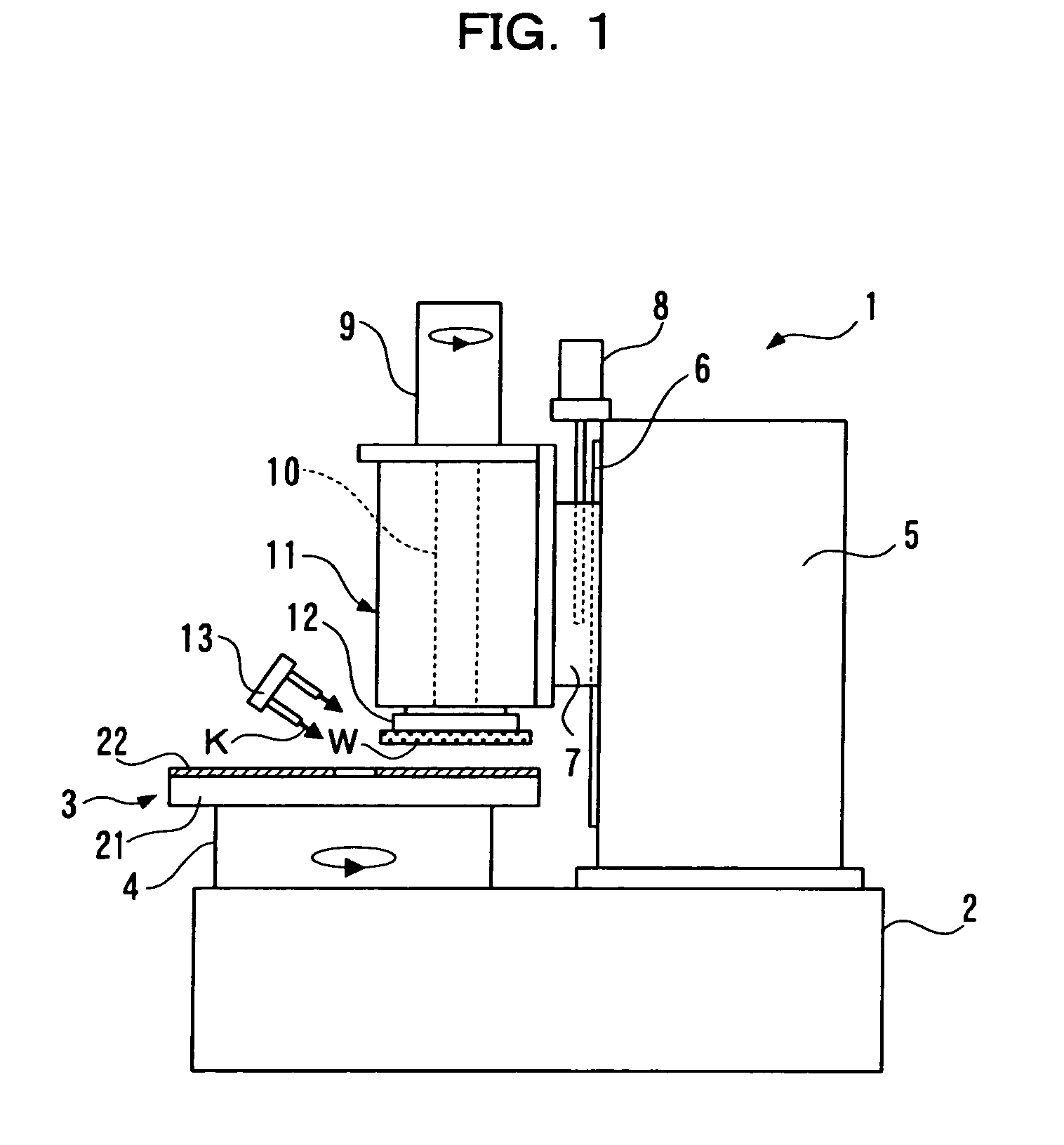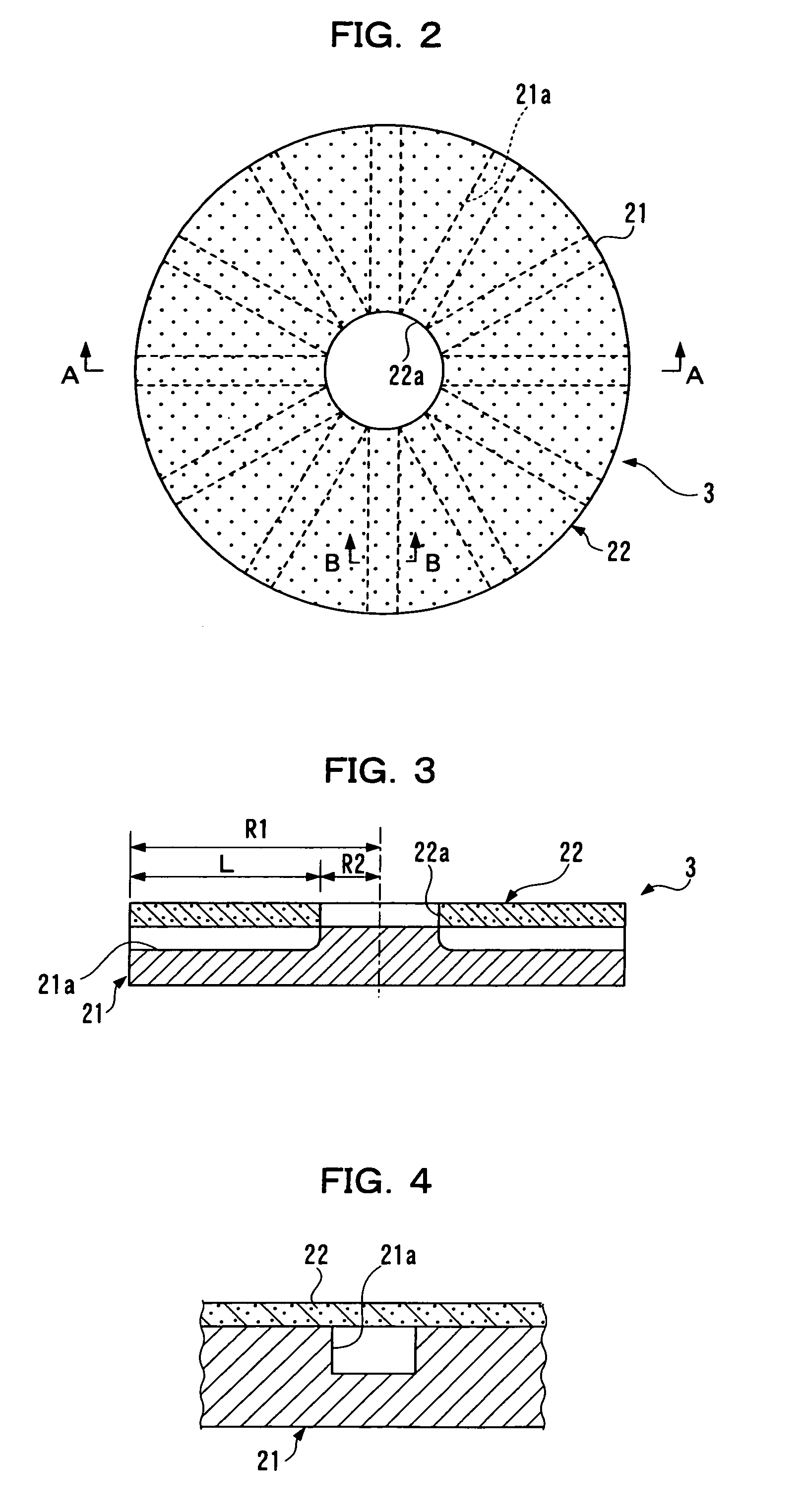Viscoelastic polisher and polishing method using the same
a technology of viscoelastic polisher and polishing method, which is applied in the direction of gear teeth, manufacturing tools, manufacturing apparatus, etc., can solve the problems of reducing the polishing performance, reducing the cost of the formation of grooves, and difficulty in providing the abrasive agent to a portion of the workpiece to be actually polished, so as to achieve the effect of reducing the cost of running
- Summary
- Abstract
- Description
- Claims
- Application Information
AI Technical Summary
Benefits of technology
Problems solved by technology
Method used
Image
Examples
first embodiment
[0055]The viscoelastic polisher according to the present invention and the polishing apparatus for polishing a workpiece with the use of the viscoelastic polisher will be described based on FIGS. 1 to 7.
[0056]First, the polishing apparatus will be explained based on FIG. 1.
[0057]The polishing apparatus 1 includes a spin base 4 provided on a bed 2 for rotating a viscoelastic polisher 3 within a horizontal plane, a support column 5 provided upright beside the spin base 4 on the bed 2, a slide member 7 attached to the support column 5 in a vertically movable manner via a vertical guide rail 6, a vertical movement motor 8 provided on an upper side of the support column 5 for vertically moving the slide member 7, for example, via a screw mechanism, a spin head 11 attached to the slide member 7 and having a rotation shaft (also referred to as “spindle”) 10 to be rotated about a vertical axis by a rotation motor 9, and a chuck 12 provided at a lower end of the rotation shaft 10 of the spin...
second embodiment
[0087]Next, a viscoelastic polisher according to the present invention will be described based on FIGS. 8 to 10.
[0088]The viscoelastic polisher according to the second embodiment includes a plurality of annular grooves concentrically provided in addition to radial grooves as provided in the viscoelastic polisher according to the first embodiment described above. In the second embodiment, only a difference from the first embodiment will be mainly described. The same components as those in the first embodiment are denoted by the same numerals, and no explanation will be given thereto.
[0089]As shown in FIGS. 8 to 10, the metal base disk 21 has a plurality of annular grooves (e.g., two annular grooves) 21b having different radii and concentrically provided in the major surface (predetermined surface) thereof in addition to the radial grooves 21a. The annular grooves 21b each have the same depth as the radial grooves 21a, and have a width slightly smaller than that of the radial grooves ...
third embodiment
[0091]Next, a viscoelastic polisher will be described based on FIGS. 11 to 13.
[0092]In the viscoelastic polisher according to the third embodiment, radial grooves provided in the viscoelastic polisher as in the first embodiment described above are each inclined with respect to the radius (center line) of the polisher. In the third embodiment, only a difference from the first embodiment will be mainly described. The same components as those in the first embodiment are denoted by the same numerals, and no explanation will be given thereto.
[0093]As shown in FIGS. 11 to 13, a plurality of radial grooves 21a′ are equiangularly provided in the major surface (predetermined surface) of the metal base disk 21 as intersecting a center line CL passing through the center O of the metal base disk 21 at an angle θ of not greater than ±15 degrees. That is, the grooves are each inclined at the predetermined angle θ with respect to the radius or the center line CL.
[0094]In this case, the same effec...
PUM
| Property | Measurement | Unit |
|---|---|---|
| angle | aaaaa | aaaaa |
| angle | aaaaa | aaaaa |
| viscoelastic | aaaaa | aaaaa |
Abstract
Description
Claims
Application Information
 Login to View More
Login to View More - R&D
- Intellectual Property
- Life Sciences
- Materials
- Tech Scout
- Unparalleled Data Quality
- Higher Quality Content
- 60% Fewer Hallucinations
Browse by: Latest US Patents, China's latest patents, Technical Efficacy Thesaurus, Application Domain, Technology Topic, Popular Technical Reports.
© 2025 PatSnap. All rights reserved.Legal|Privacy policy|Modern Slavery Act Transparency Statement|Sitemap|About US| Contact US: help@patsnap.com



